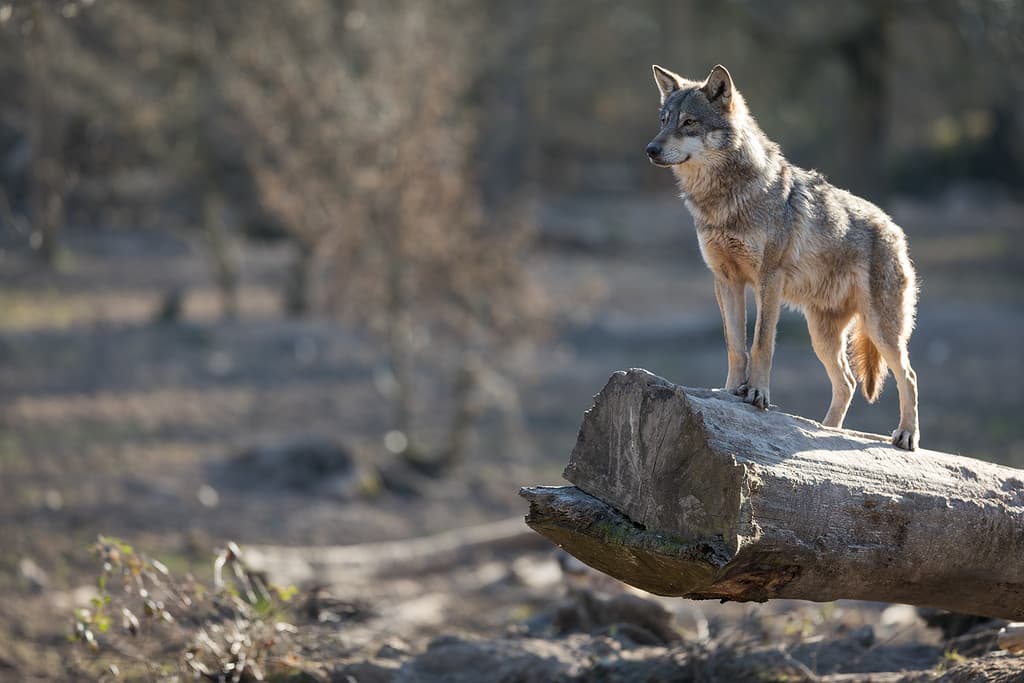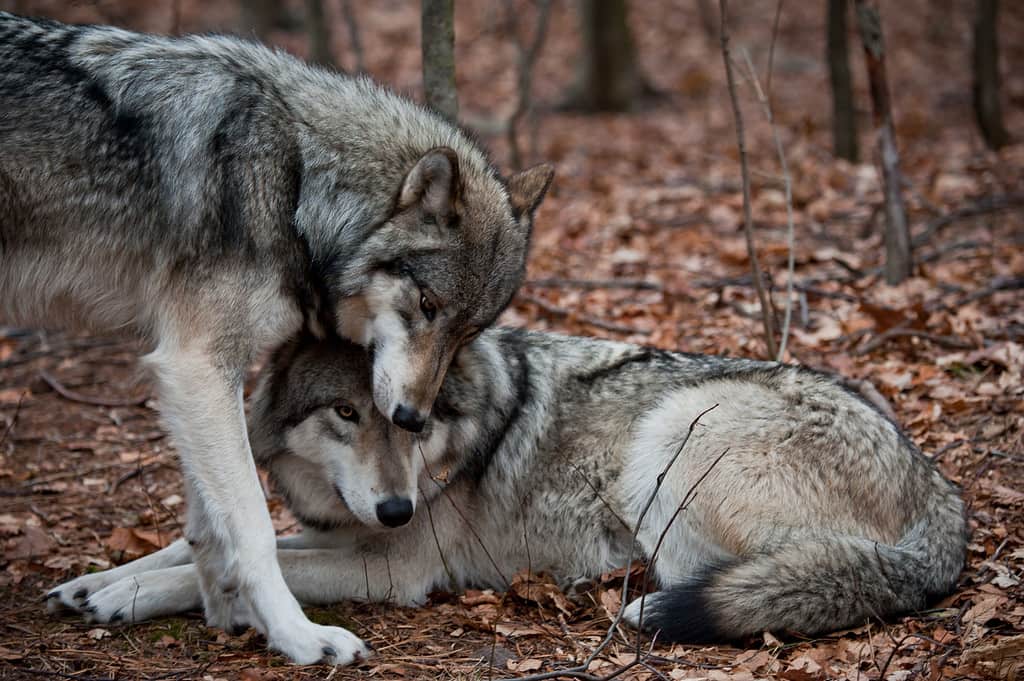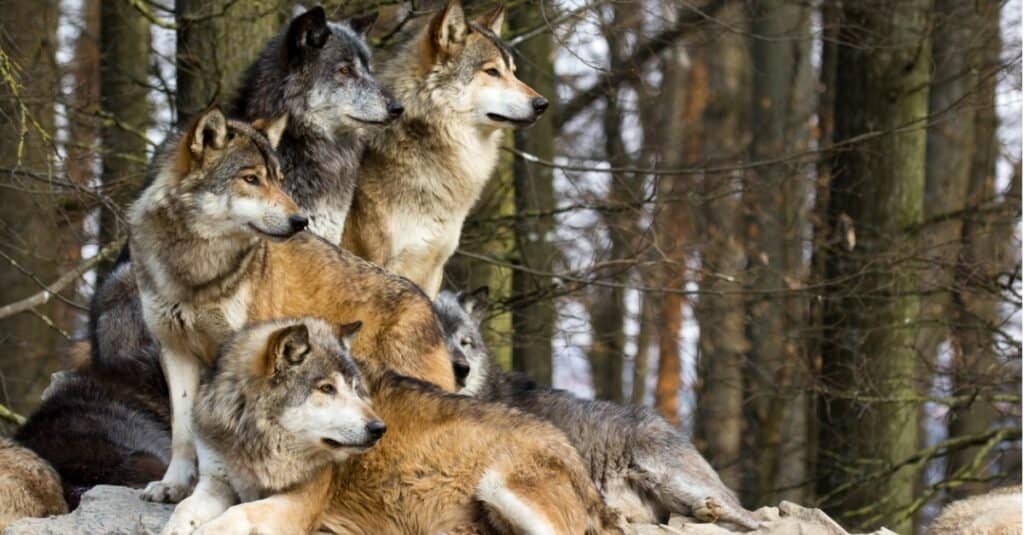Wolves are incredible, intelligent animals that live together in tight-knit families. They care for both their young as well as their elderly, working together to ensure the well-being of the entire pack. For centuries gray wolves roamed across much of North America as apex predators, regulating populations of prey animals and keeping ecosystems balanced. However, when European settlers arrived, fear and competition for land led them to hunt and kill so many wolves that wolves nearly disappeared completely. So, where do wolves live in Pennsylvania today?
Are There Wolves in Pennsylvania?

Grey wolves are an Endangered Species.
©AB Photography/ via Getty Images
Although gray wolves (Canis lupus) once roamed across at least two-thirds of the United States, they were locally extirpated in many states. This means that the population of wolves disappeared from specific areas completely.
Fortunately, wolves have made a comeback in many states. They now roam wild again in western regions like Yellowstone National Park in Wyoming, as well as in Montana, Idaho, and Oregon. In addition, there are even populations living in Michigan, Wisconsin, and Alaska.
Currently, there are no wild wolf populations in Pennsylvania. However, that doesn’t mean there aren’t any wolves in the state. In fact, just north of Lititz, PA, the Wolf Sanctuary of PA provides a safe haven for over 50 rescued wolves!
The Wolf Sanctuary of PA

Wolves care for each other more than some humans do!
©RamiroMarquezPhotos/iStock via Getty Images
Bill and Barbara Darlington opened their nonprofit Wolf Sanctuary back in 1980. It is still run by their family today, with more than 50 gray wolves and wolf-dogs living on over 80 acres of natural woodland. However, the Wolf Sanctuary of PA is more than just a safe haven for these remarkable animals — it also serves as an educational bridge between wolves and humans.
For centuries numerous myths, legends, and scary stories have made humans fear and hate wolves — but the Wolf Sanctuary is striving to fix that! Visitors can enjoy guided tours of the sanctuary and learn the truth about wolves — how they are vital to the ecosystem as a keystone species, and how we can share this world with them peacefully. There is a lovely Bed and Breakfast right across the road, and you can even get to know each of the amazing wolves through the sanctuary’s website.
Why Are Wolves So Important?

Wolves are efficient hunters and only take what they need.
©iStock.com/Neil_Burton
Wolves are expert predators in the wild and sustain the ecosystems where they live. As apex predators, they’re at the top of the food chain, hunting prey animals like deer and elk. However, they are intelligent and purposeful hunters, targeting only weak and sick animals. Although this may sound cruel, in reality, it helps the deer herds stay healthy and strong. This keeps their populations in check and maintains balance in the environment.
When wolves disappeared from Pennsylvania, the state’s deer populations went wild without any predators to control them. The enormous deer populations munch on just about every plant they can find, decimating habitats around the state. They especially love tender young trees, which makes it difficult for new ones to grow. This also destroys the habitats of other small animals and disrupts the entire ecosystem.
Without wolves in Pennsylvania, populations of other smaller predators took over, including coyotes. The problem with this is that while coyotes are great hunters, they’re built for much smaller prey. This means that they can’t control the deer and elk populations in Pennsylvania like the wolves did.
Could Wolves Return to Pennsylvania in the Future?

Each member of a wolf pack has a specific role that helps the entire group survive and thrive.
©iStock.com/Cloudtail_the_Snow_Leopard
There aren’t any wild wolf packs living in Pennsylvania yet, but many conservationists are working to bring them back. However, wolves need a lot of wild space to roam, hunt, and raise their pups. They can’t rebuild and thrive in areas filled with busy roads and human developments.
Scientists have been searching the state, and have found a few promising locations for wolves to successfully live. These areas are far from human settlements and have lots of connected forests and healthy populations of prey animals. But there are still many things to consider, such as if these spaces are large enough to sustain wolf populations in the long run. Another concern is the people living in Pennsylvania — will they be okay with having wolves return to the state? If the people aren’t on board, it can be very dangerous for the wolves, as some may even attempt to hurt and persecute them.
If wolves are reintroduced into the state in the future, the Pennsylvania Game Commission and the U.S. Fish and Wildlife Service would track their populations, ensure they have plenty of suitable habitats, and intervene in any human-wolf interactions to help residents live peacefully alongside wolves.
Would Wolves in Pennsylvania Be Dangerous to Humans?

Wolves rarely attack humans.
©AB Photographie/Shutterstock.com
Many people worry about reintroducing wolves into Pennsylvania. These animals are indeed formidable, apex predators, but they likely wouldn’t pose a significant threat to the state’s residents. In reality, wolves are more scared of us than we are of them. In fact, you’re much more likely to get bitten by your own pet dog than by a wild wolf! They are naturally shy and wary of humans, avoiding contact as much as possible. Wolf attacks are extremely uncommon, even in regions where wolf populations are stable. We must give them the respect they deserve as wild animals. It is completely possible to coexist together in the same state.
In addition, humans simply are not on a wolf’s menu, especially when there are plenty of prey animals in the state. White-tailed deer, for example, would be their primary food source, though they may also hunt smaller prey animals like beavers, rabbits, and mice.
The photo featured at the top of this post is © Szczepan Klejbuk/Shutterstock.com
Thank you for reading! Have some feedback for us? Contact the AZ Animals editorial team.







